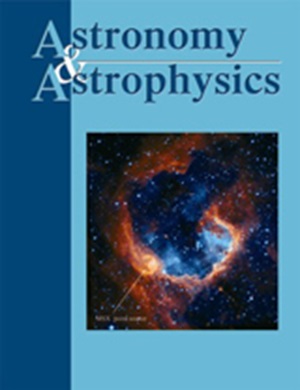The CARMENES search for exoplanets around M dwarfs
IF 6.5
2区 物理与天体物理
引用次数: 9
Abstract
Context. For years, the standard procedure to measure radial velocities (RVs) of spectral observations consisted in cross-correlating the spectra with a binary mask, that is, a simple stellar template that contains information on the position and strength of stellar absorption lines. The cross-correlation function (CCF) profiles also provide several indicators of stellar activity. Aims. We present a methodology to first build weighted binary masks and, second, to compute the CCF of spectral observations with these masks from which we derive radial velocities and activity indicators. These methods are implemented in a python code that is publicly available. Methods. To build the masks, we selected a large number of sharp absorption lines based on the profile of the minima present in high signal-to-noise ratio (S/N) spectrum templates built from observations of reference stars. We computed the CCFs of observed spectra and derived RVs and the following three standard activity indicators: full-width-at-half-maximum as well as contrast and bisector inverse slope. Results. We applied our methodology to CARMENES high-resolution spectra and obtain RV and activity indicator time series of more than 300 M dwarf stars observed for the main CARMENES survey. Compared with the standard CARMENES template matching pipeline, in general we obtain more precise RVs in the cases where the template used in the standard pipeline did not have enough S/N. We also show the behaviour of the three activity indicators for the active star YZ CMi and estimate the absolute RV of the M dwarfs analysed using the CCF RVs.CARMENES 搜寻 M 矮星周围的系外行星
背景多年来,测量光谱观测径向速度(RVs)的标准程序是将光谱与双掩模(即包含恒星吸收线位置和强度信息的简单恒星模板)进行交叉相关。交叉相关函数(CCF)剖面还提供了恒星活动的一些指标。我们提出了一种方法,首先建立加权二元掩模,其次计算使用这些掩模进行光谱观测的 CCF,并从中得出径向速度和活动指标。这些方法通过公开的 python 代码实现。为了建立掩模,我们根据参考恒星观测数据建立的高信噪比(S/N)光谱模板中存在的极小值轮廓,选择了大量尖锐的吸收线。我们计算了观测到的光谱的 CCFs 和得出的 RVs,以及以下三个标准活动指标:半最大全宽、对比度和平分线反斜率。我们将我们的方法应用于CARMENES高分辨率光谱,获得了CARMENES主巡天观测到的300多颗M矮星的RV和活动指标时间序列。与标准的CARMENES模板匹配管道相比,在标准管道使用的模板信噪比不足的情况下,我们通常能获得更精确的RV。我们还展示了活动恒星 YZ CMi 的三个活动指标的表现,并利用 CCF RVs 估算了所分析的 M 矮星的绝对 RV。
本文章由计算机程序翻译,如有差异,请以英文原文为准。
求助全文
约1分钟内获得全文
求助全文
来源期刊

Astronomy & Astrophysics
ASTRONOMY & ASTROPHYSICS-
自引率
27.70%
发文量
0
期刊介绍:
Astronomy & Astrophysics is an international Journal that publishes papers on all aspects of astronomy and astrophysics (theoretical, observational, and instrumental) independently of the techniques used to obtain the results.
 求助内容:
求助内容: 应助结果提醒方式:
应助结果提醒方式:


